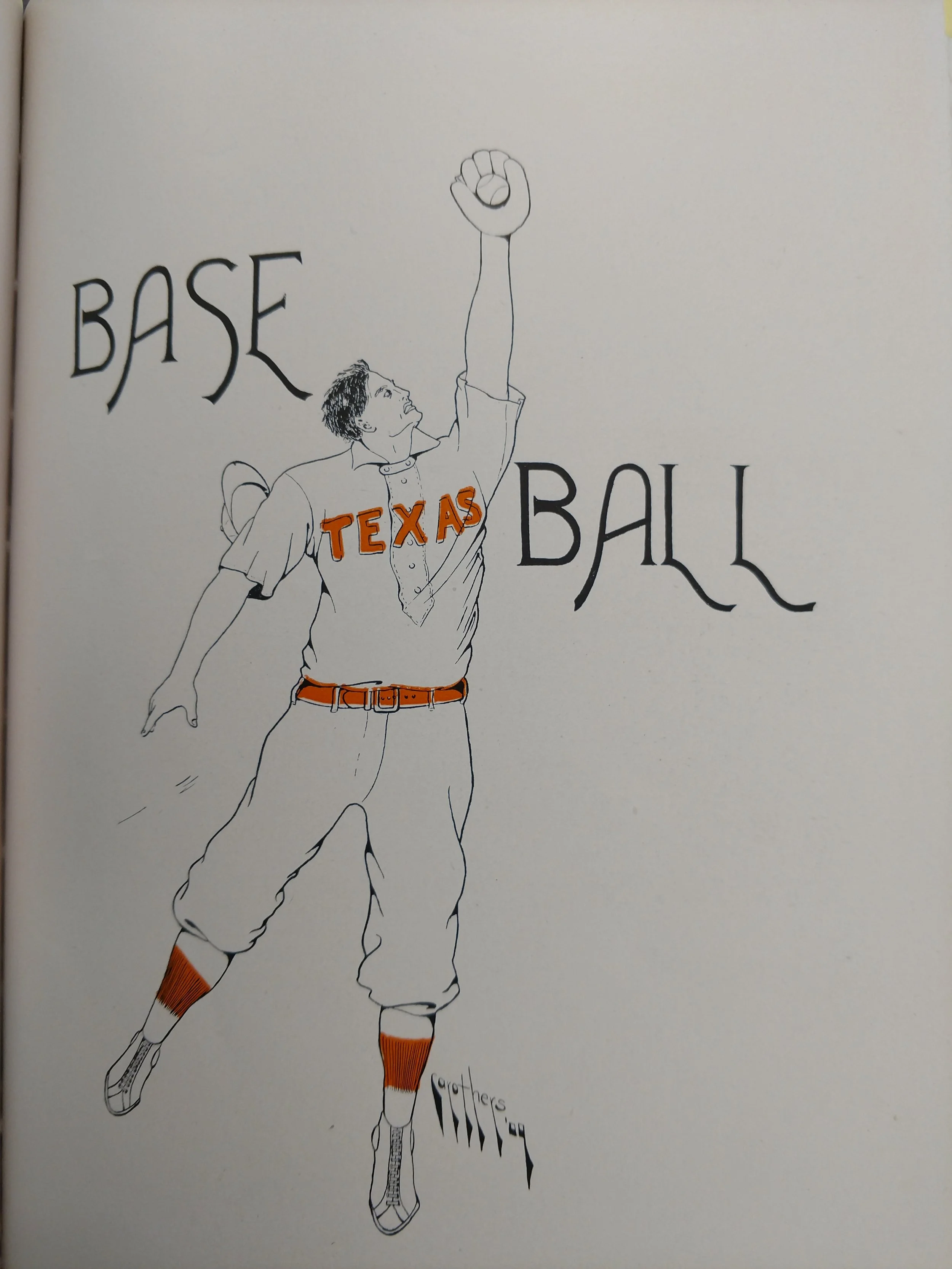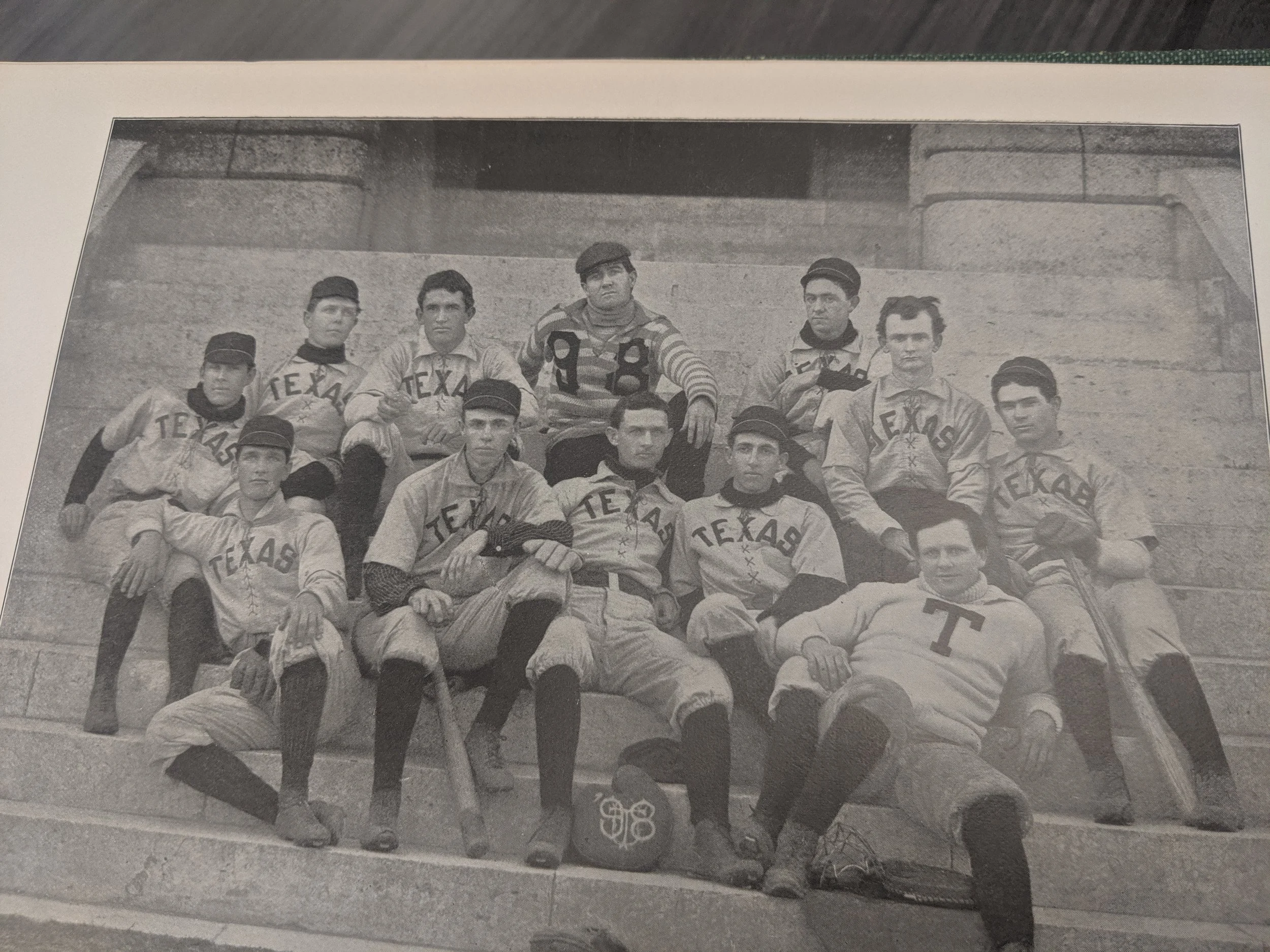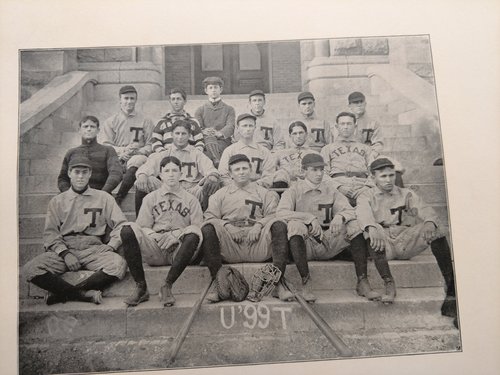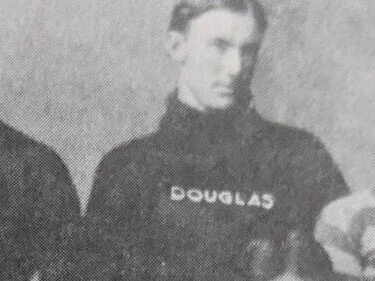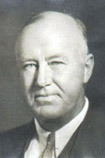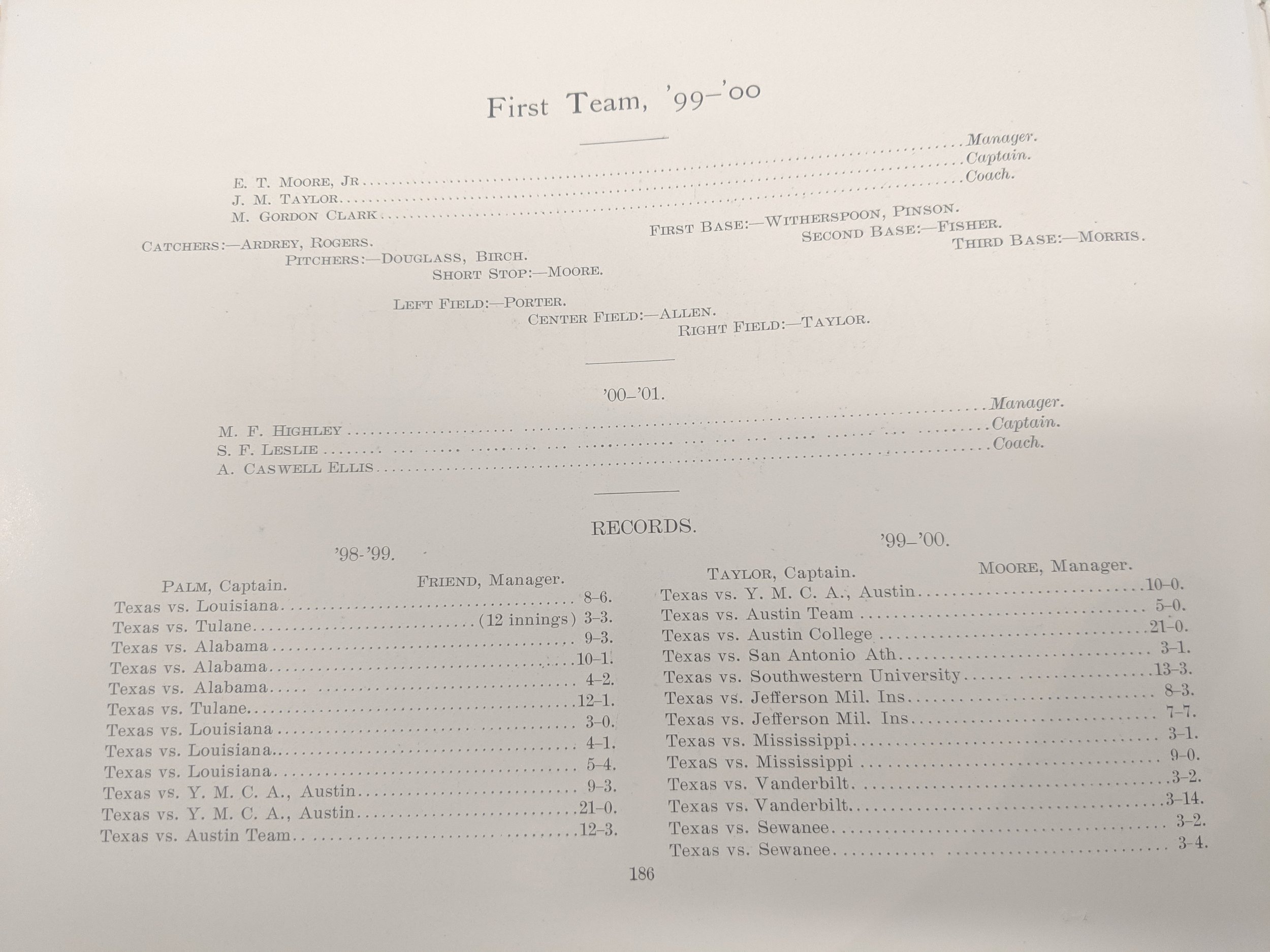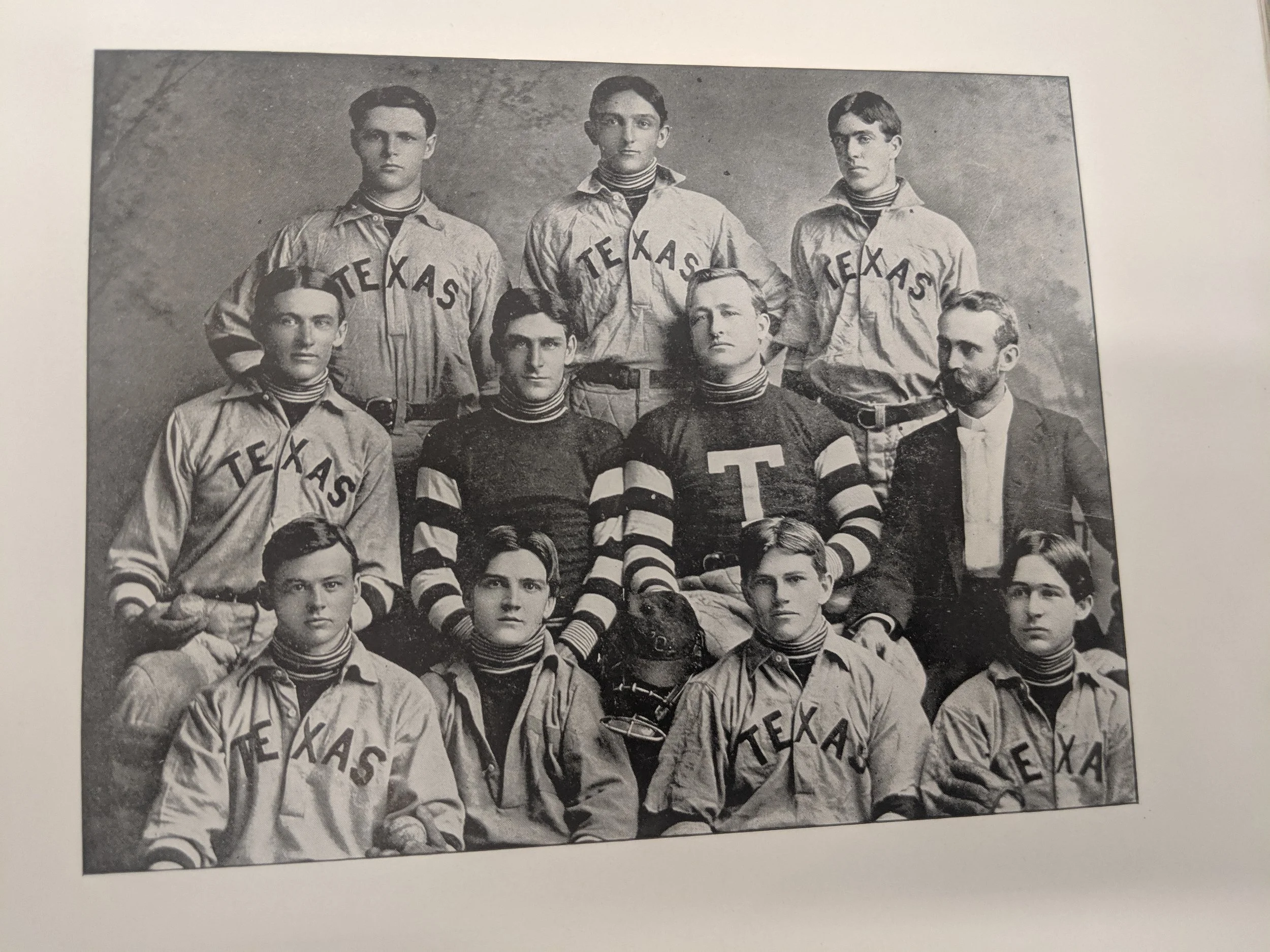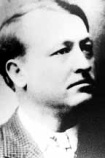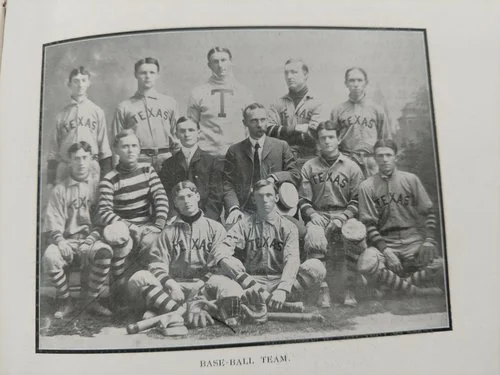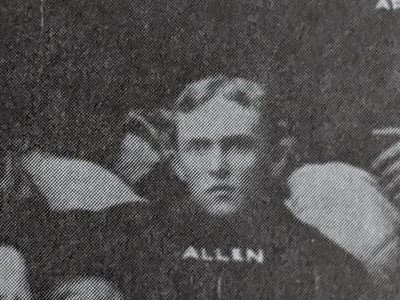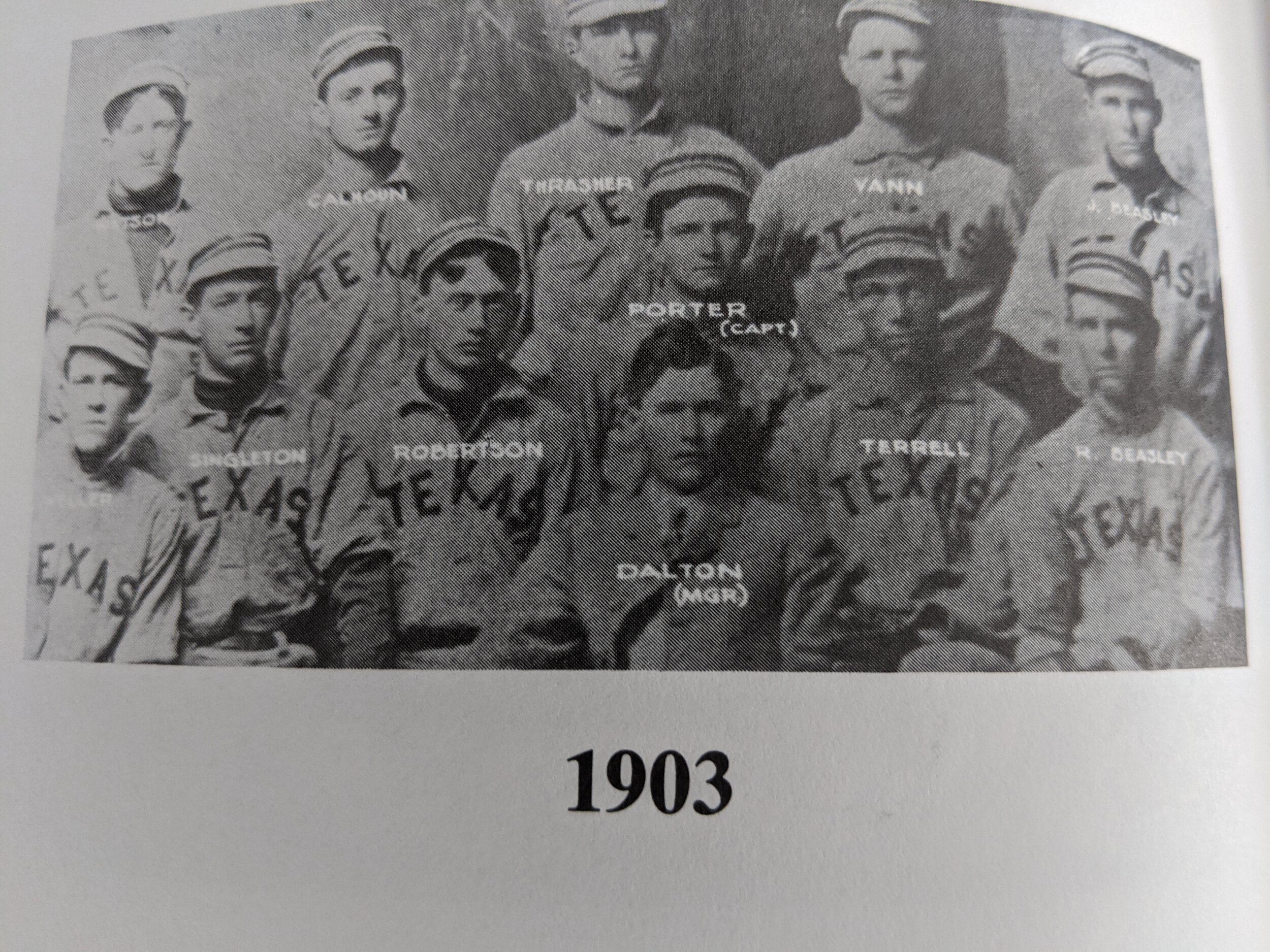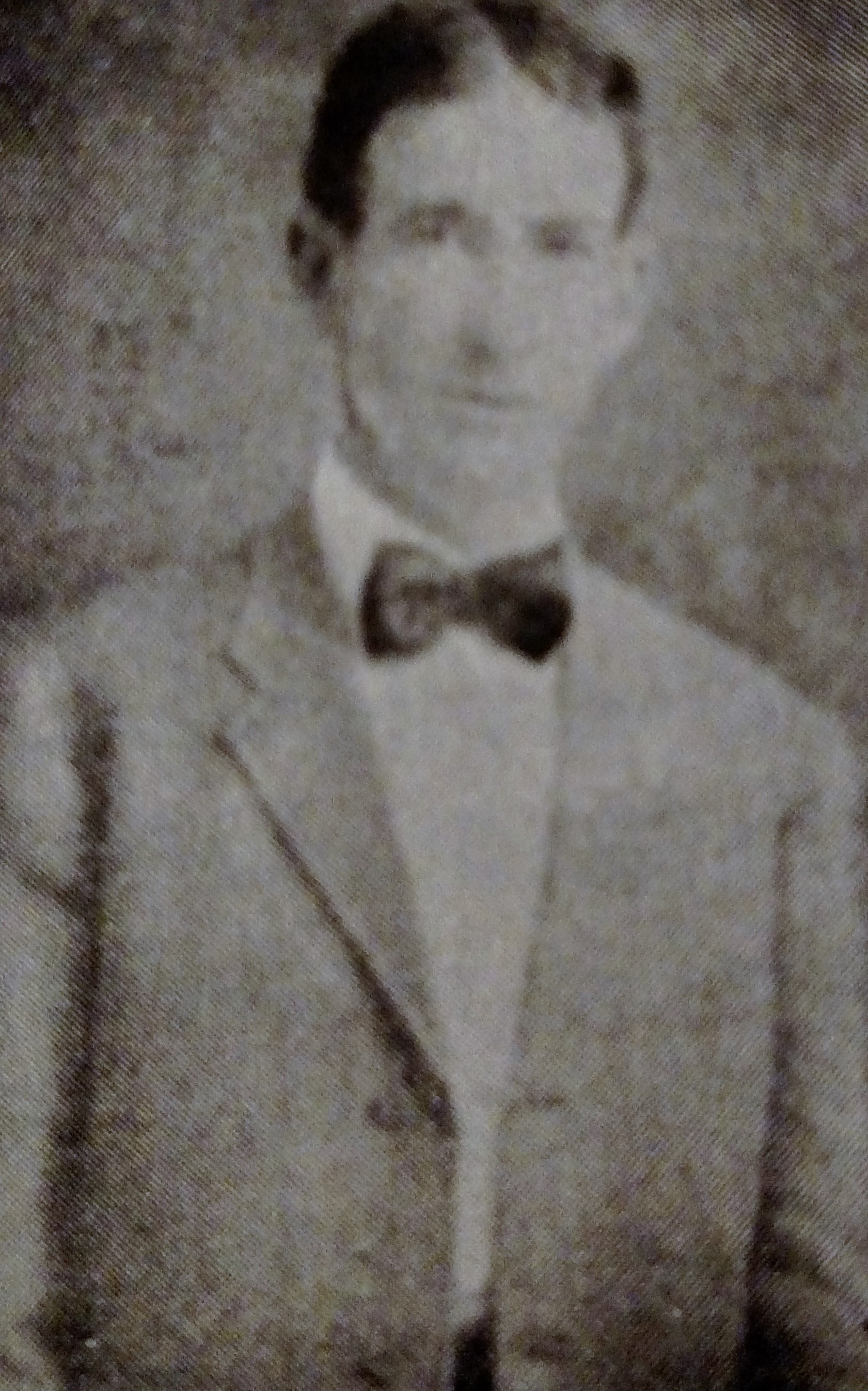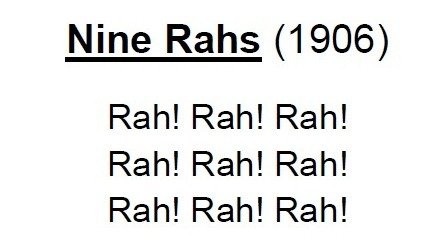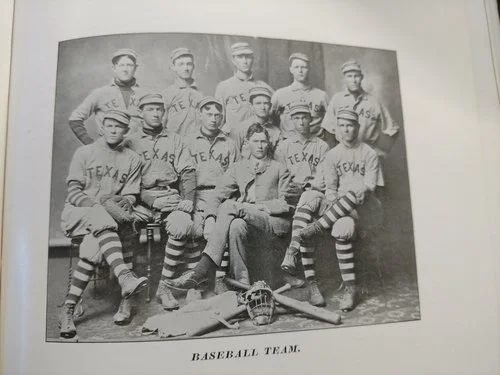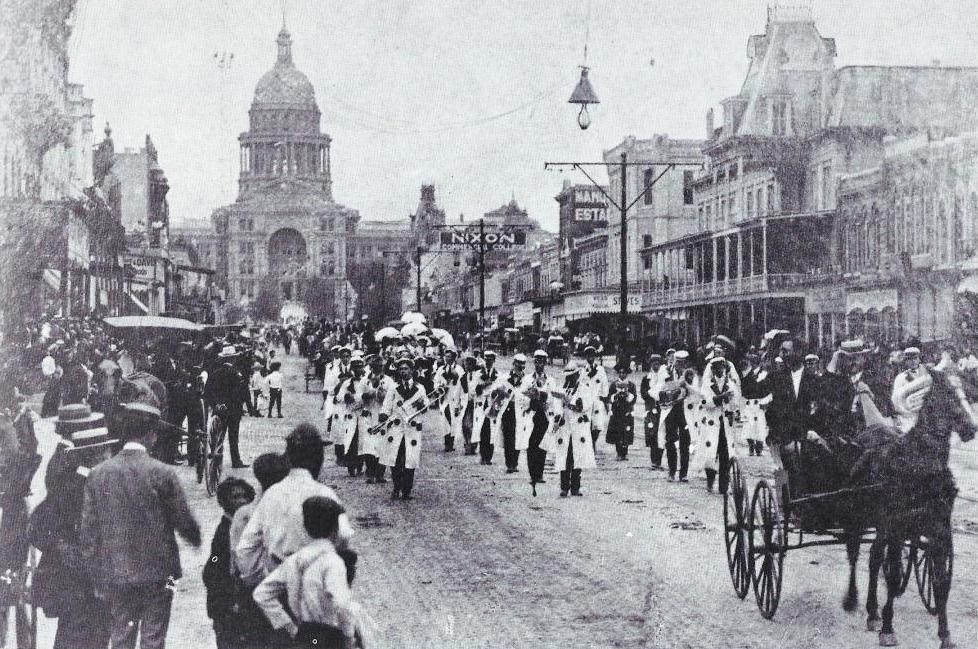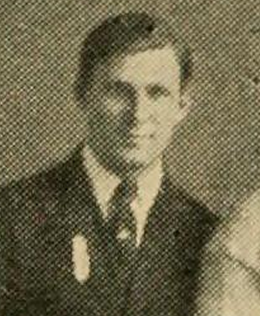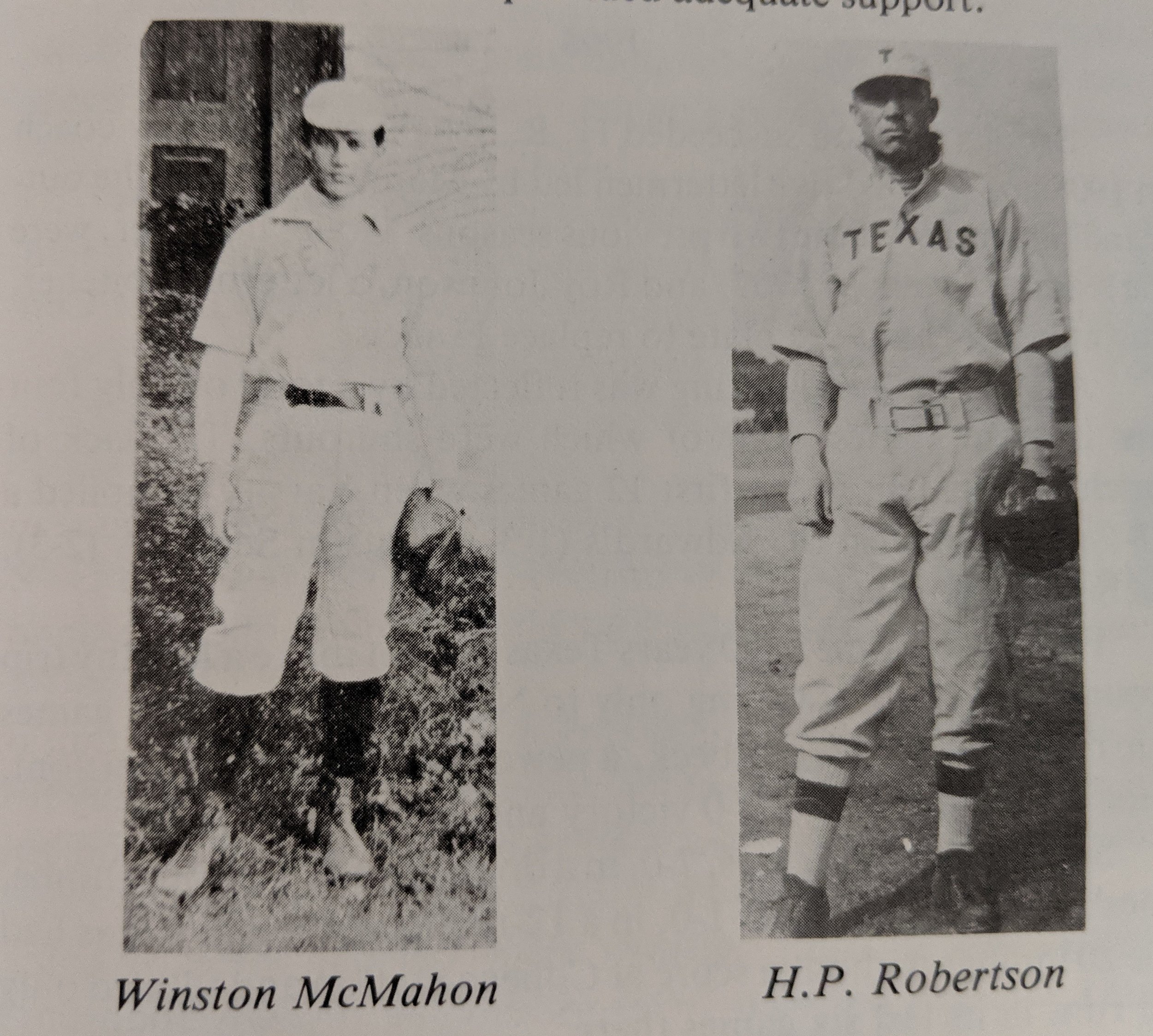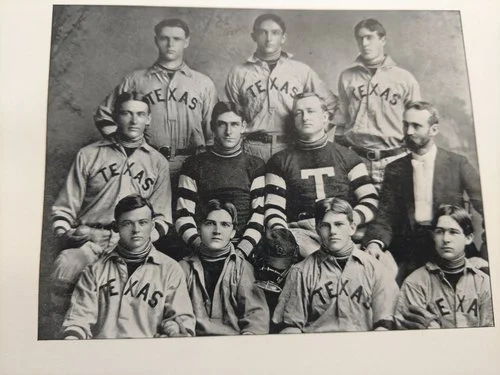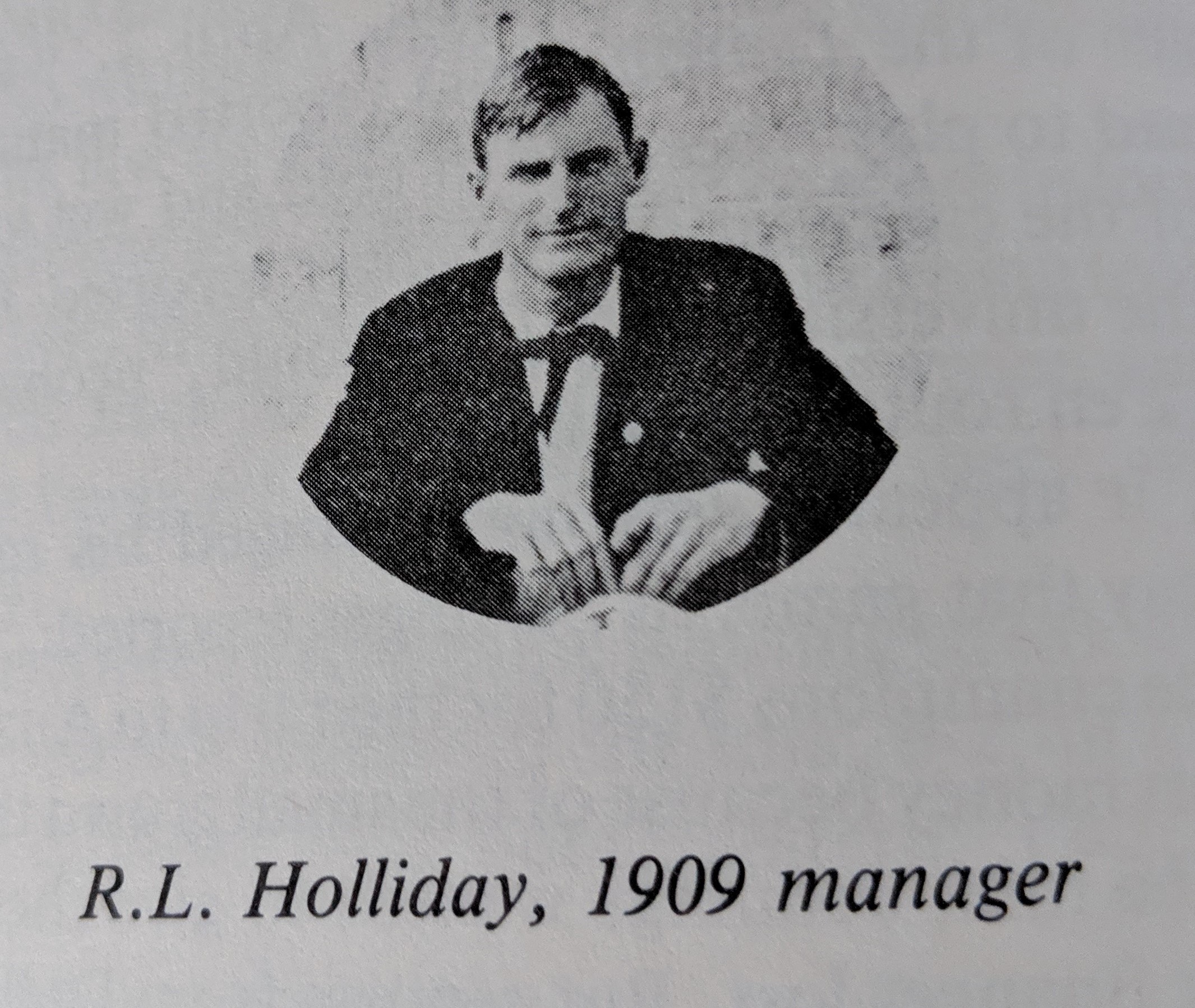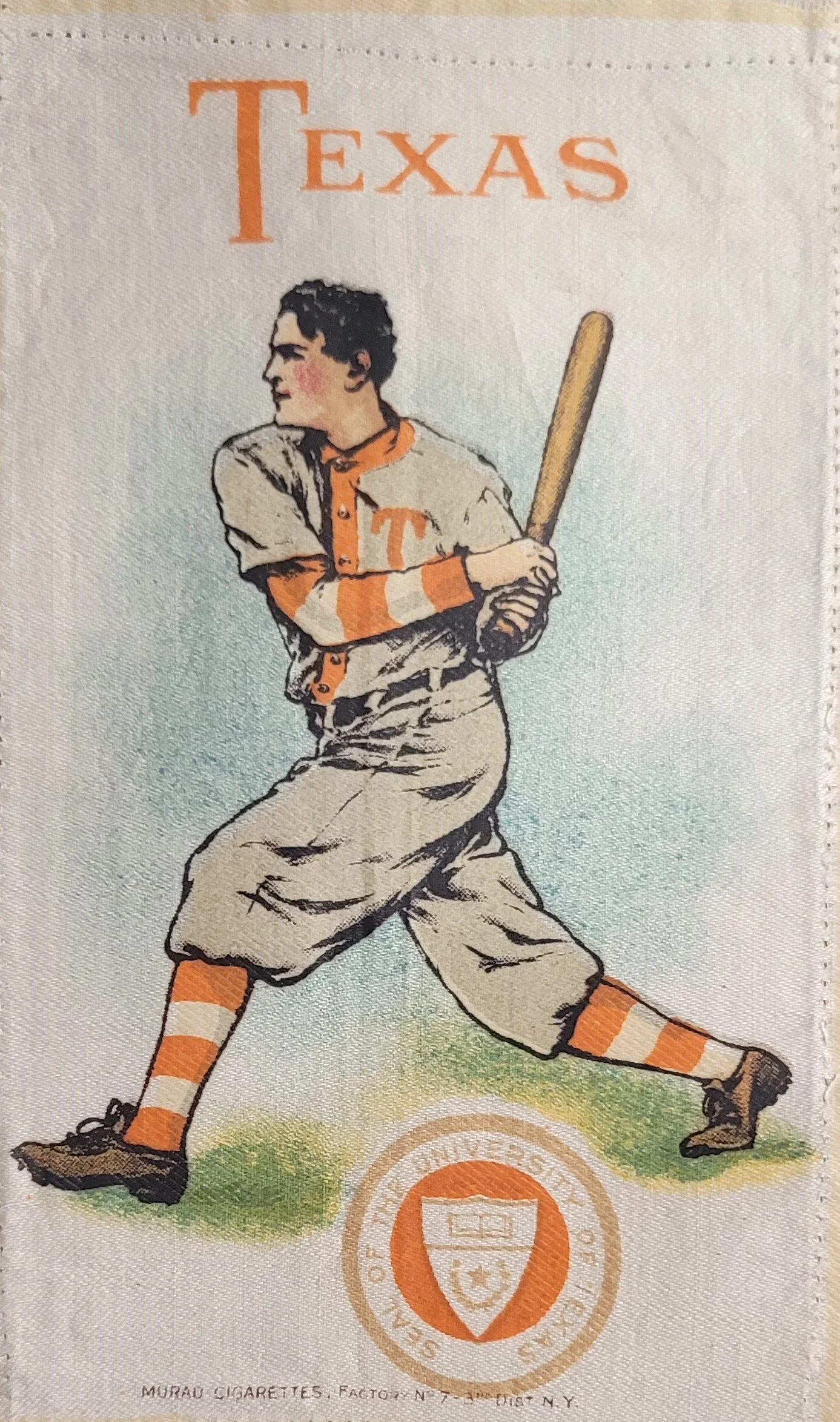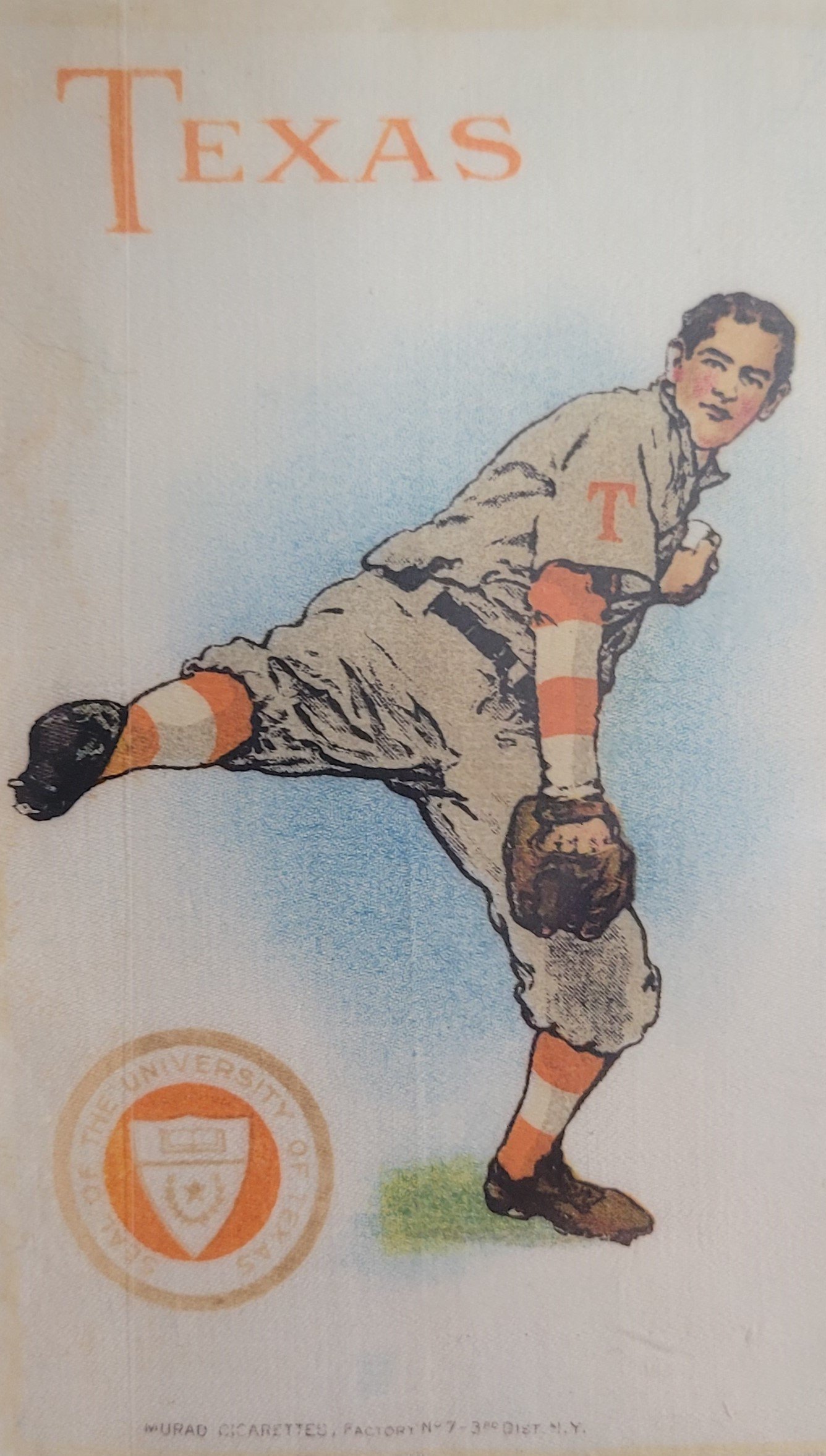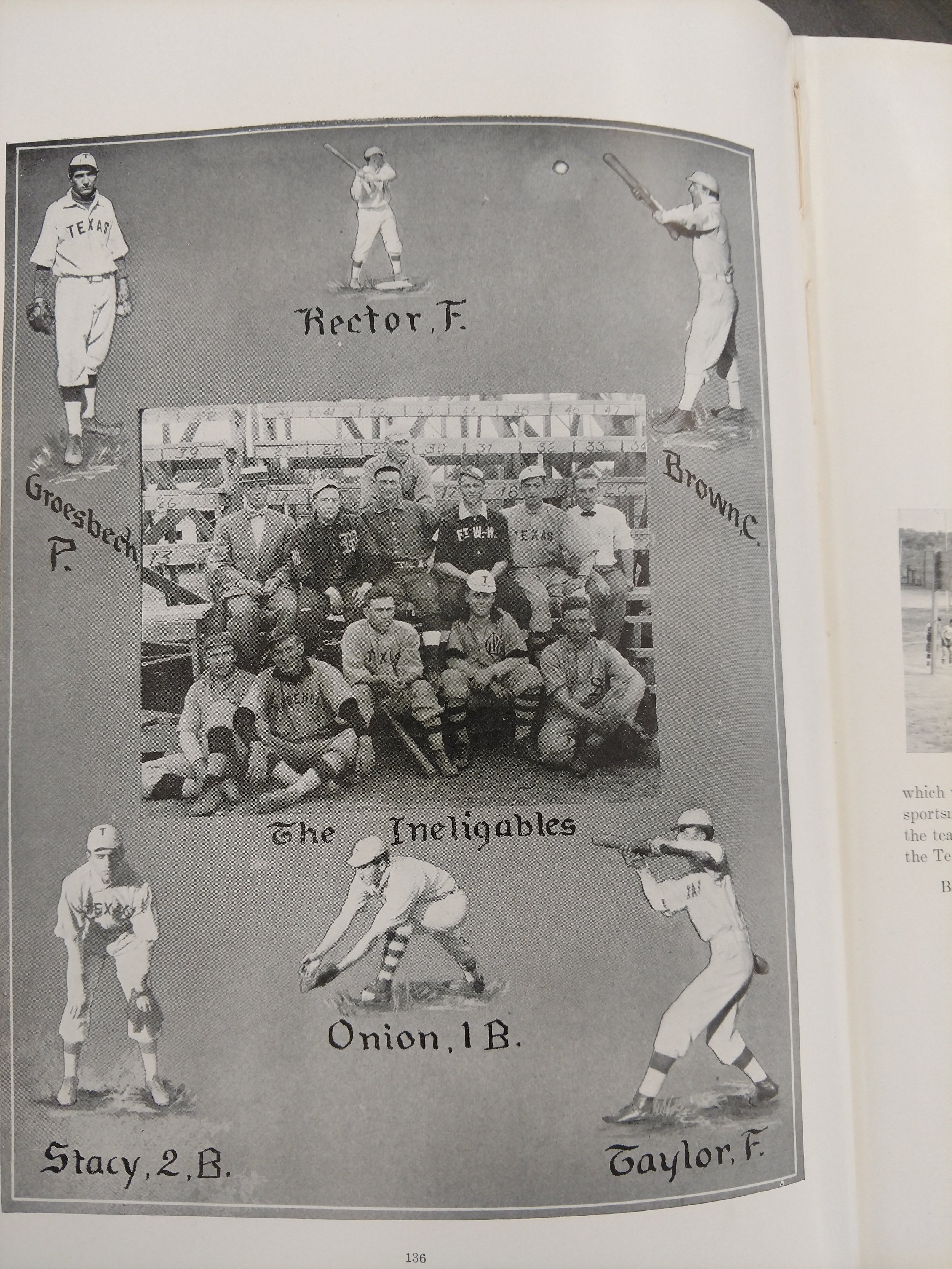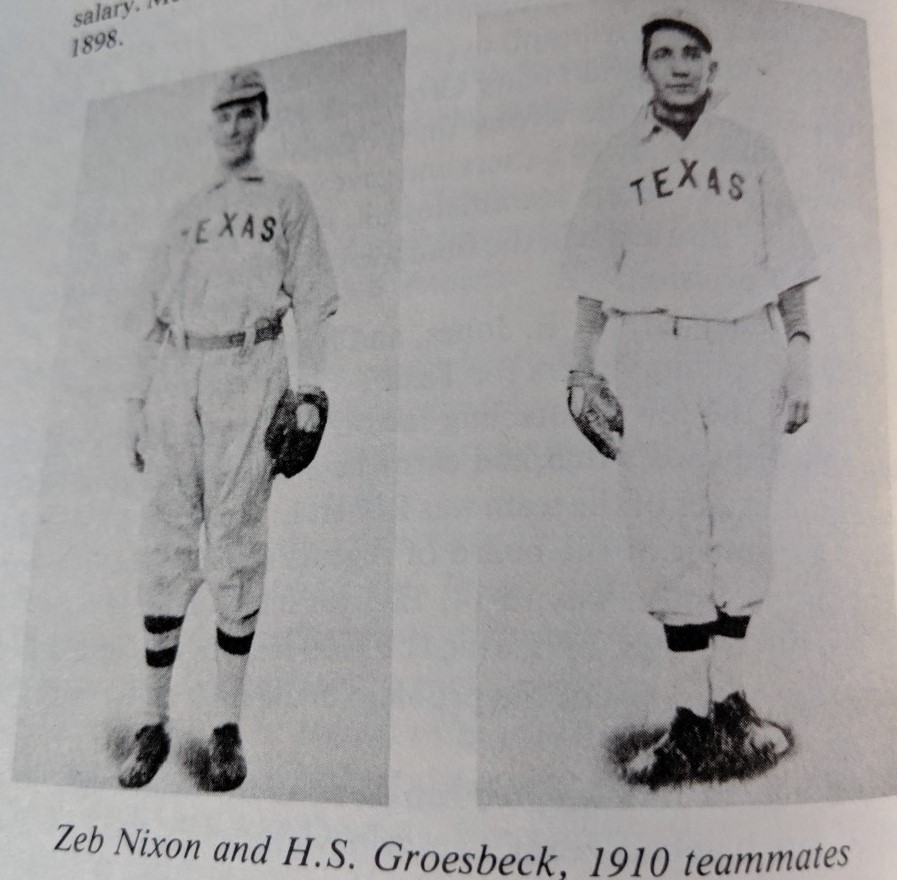“Click on the text denoted in red font on the side bar to visit other sites in this grid”
The science of the fastball is in the link below.
https://www.facebook.com/thebsbking/videos/299378973999823/?t=106
in the book “Loving Sports” the authors say that baseball is an allegory for life. You only have to bat .300 to be considered successful. In baseball, more than any other sport, David beats Goliath often.
Artwork is from the "Cactus" It was the leisure time sport for the working class moving from agrarian to urban life.
The article below is from Texassports.com.
Baseball, not football, was the sport of choice for UT students in the 1880s. In the spring of 1885, when the University was not yet two years old, a student enrolled who claimed to have the only curveball pitch in the state. The curveball was a new addition to the game, welcomed by baseball progressives and hated by the sport's purists. Nevertheless, University students formed a team "that rated high in brainpower, low in brute force," and challenged any college in Texas to a game. Thirty miles north in Georgetown, Southwestern University answered the call and invited UT to a picnic and baseball contest. The University accepted, and students arranged to make the trip to Georgetown on a chartered train.
On a Saturday morning in April 1885, the first UT baseball team and most of the student body arrived at the downtown Austin train station at 3rd Street and Congress Avenue and boarded the passenger cars bound for Georgetown. Everything was on schedule until the final whistle sounded. Just as the train was ready to leave, two coeds announced the need for some ribbon to identify them as University of Texas supporters.
Today's college fans arrive at stadiums clad in t-shirts and caps. But in the 1880s, colored ribbons were worn on lapels to show team loyalty. The more enterprising male students sported longer ribbons, so they would have extra to share with a pretty girl who had none. The truly ingenious (or just plain desperate) wore ribbons almost down to their knees.
The dates of the two Texas coeds, Venable Proctor and Clarence Miller, ever eager to impress the ladies, jumped off the train and sprinted a block north along Congress Avenue to the nearest general store. They managed to ask the shopkeeper for three bolts of two colors of ribbon between gasps for breath. "What colors?" the shopkeeper asked. "Anything," was the response. After all, the train was leaving the station, and there was no time to be particular.
The shopkeeper gave them the colors he had the most in stock: white ribbon, which was popular for weddings and parties and was always in demand, and bright orange ribbon because no one bought the color, and the store had plenty to spare.
Loaded with their supplies, Proctor and Miller ran back and boarded the moving train as it left for Georgetown. Along the way, the ribbon was evenly divided and distributed to everyone except for a law student named Yancey Lewis, "who had evolved a barbaric scheme of individual adornment by utilizing the remnants."
Unfortunately, it rained that Saturday afternoon, the curveball curved not, and Texas outfielders ran weary miles in a lost cause. According to one witness, the University's colors were "christened on a dire and stricken field."
Or were they? Even though the first baseball team had sported orange and white, the colors were by no means official and subject to future UT students' whims.
After a decade of starts and stops, the University of Texas fielded its first "permanent" football team in 1893. The first recorded game was actually ten years earlier, during UT's very first fall term, though it was a rather embarrassing two-goals-to-none loss against a group of high school students at the Bickler School in downtown Austin. Football, the newfangled sport that could draw 50,000 spectators to a Princeton-Yale game in the 1880s, required a little more time to be accepted in the Lone Star State.
The UT football team of 1893 played four games, a pair in the fall and two more in the spring. The first was against the Dallas Foot Ball Club that claimed to be the best in the state. Held at the Dallas Fair Grounds, the game attracted a record 1200 onlookers. It was a tough and spirited match, but the "University Eleven" had pulled off an 18 - 16 upset when the dust had settled. "Our name is pants, and our glory has departed," growled the Dallas Daily News. The UT club would go on to a spotless record and earn the undisputed boast of "best in Texas."
The University team, though, didn't wear orange. Their striped uniforms were gold and white.
Painting in the "Cactus" in the 1900's
In the 1890s, the forty-acre UT campus consisted of a still-unfinished Victorian-Gothic Main Building, a chemical lab building to its northwest, and a plain-looking men's dorm Brackenridge Hall, or "B." Hall, nestled down the hill to the east. All were fashioned from pale yellow Austin pressed brick and trimmed with cream-colored limestone quarried in nearby Cedar Park. (The Gebauer Building, built-in 1904 for engineering, is today the home for College of Liberal Arts and is the last survivor of this early UT architecture.) Students identified themselves with their surroundings on the campus, and several University teams donned gold and white uniforms.
Of course, gold and white weren't official, either, and only lasted a couple of years. Members of the student-run UT Athletic Association wanted a more "masculine" color, and in 1895 orange was paired with white once more. White uniforms, though, were difficult to clean after a hard-fought victory on the football field. In 1897, to save cleaning costs, the Athletic Association opted for a darker color that wouldn't show dirt as easily: maroon.
For the next three years, UT football, baseball, and track uniforms, along with letter sweaters, were orange and maroon. This created more than a little controversy, especially among the alumni. Adding to the confusion was the Cactus Yearbook, at the time published by the Athletic Association, which listed the University colors as either gold or orange and white. The appearance of the 1899 Cactus made matters worse. It suddenly declared the University colors to be "Gold and Maroon," which just happened to be the same hues used for the yearbook's cover. And all the while, students at the University's medical branch in Galveston wanted to throw out the double-colors in favor of a single one: royal blue. Attending a football game in 1899, a UT fan would have found his compatriots sporting all shades of yellows, oranges, whites, reds, maroons, and a few in blue.
After considerable discussion, the Board of Regents decided to hold an election to settle the matter. Students, faculty, staff, and alumni were all invited to send in their ballots. Out of the 1,111 votes cast, 562 were for orange and white, a majority by just seven votes. Orange and maroon receive 310, royal blue 203, crimson 10, royal blue and crimson 11, and few other colors scattered among the remaining 15 votes.
The Texas Longhorns have won the most games are the winningest team in college baseball history with 77 conference championships, 35 College World Series, 12 appearances to the Championship game, and 6 national champions (1949, 1950, 1975, 1983, 2002, 2005).
Since 1895 there have been 13 baseball head coaches at Texas. Since 1911 there have only been 6 full-time coaches.
From 1895-2015 the won-loss collegiate record is 3252-1073-28 with 35 College World Series tournaments.
Texas ties LSU with most members in the College Baseball Hall of Fame- Kirk Dressedorfer, Bibb Falk, Cliff Gustafson, Burt Hooten, Brooks Kieschnick, Keith Moreland, Greg Swindell, and Richard Wortham are the Longhorns in the hall of fame.
Clark Field #I is the home of Longhorn baseball from the 1890s until 1927. There is also a Clark Field #2 to be discussed later.
1885-1894
Longhorn baseball pre-dates football and basketball. The first organized game was in 1885 – one year after the first classes began. April 21, 1885, is one of the first recorded games playing Southwestern University.
The Willaimson County Sun in Georgetown states the following:
April 21st, 1885, Texas visited Georgetown to play a baseball game against Southwestern University. “ two extra coaches form part of Tuesday's train from Austin these coaches containing the select nine of the State University baseball club and a large number of visitors including several ladies who came to witness the match between the State University 9 and the picked 9 From Southwestern University. About 3:30 the game began and was witnessed by a good many of our citizens and the visitors mentioned. The players on both sides exerted themselves strenuously, evidently determined that the best of all their skill should be used to achieve success on the southwestern campus on the 49th anniversary of the decisive battle of San Jacinto. The game lasted until about 6:00 o'clock and was watched with intense interest, cheers frequently rending the air as one side of the other would make a score. Each side was entitled to play nine innings. The Austin man played their full number while the Georgetown 9 played only eight innings when the game closed; the record showed that the Austin had six scores and the Georgetown nine had 21 scores, of course, the result was very gratifying to the winners who however conducted themselves with moderation while the departed 9 seemed to think that the victory had been fairly one period.
1892 - By Jim Nicar
In the spring of 1892, University sports became better organized with the birth of the UT Athletic Association. With its assistance, the baseball team played an extended scheduled in 1892, highlighted by a challenge from the much-heralded squad in San Marcos, whose members reportedly considered themselves to be the best in the state. As it was in 1885, the game was scheduled for San Jacinto Day on April 21st, the lone holiday UT students enjoyed all spring.
“A swarm of flies could not have welcomed a patch of honey with more eagerness than did the University students San Jacinto Day,” declared The Texas University, a monthly magazine published by the student literary societies. “Our desert has few oases, and when a holiday finally arrives, the students break from their localities like young mules from a very small enclosure.” The baseball team and most of the 365 enrolled students packed picnic lunches and boarded a specially chartered train for San Marcos. But unlike their 1885 counterparts, this group was prepared with a yell.
“We must have a yell for the unsuspecting citizens of San Marcos,” recalled Ed Blount, who was then the Exchanges Editor of the magazine. Blount corresponded with the literary societies of other universities, read their publications, and for each issue of the UT magazine compiled a column on college life around the country. While reading through student publications of eastern universities, he was struck by “how fondly and frequently they referred to their college colors and yells.” A few days before the April 21st holiday, Blount recruited help from fellow students Jim Bailey and Hans Hertzberg, tore a page from his notebook, and scribbled and posted a crude sign for a mass meeting of students that afternoon.
The first official game was in 1894. One year after Captain James Morrison organized the football team. There was no coach for the first game, and on thanksgiving day, the Horns defeating the Dallas Football Club 18-16.
Wentworth joins the team as a coach. The team record was 9-1 with only one loss to Missouri.
1895-1910
There Are 8 Different "Managers" During This Period and Conference Titles in the SIAA Or SWIAA.
From 1897 through 1910 won .620 percentage of their games (165-95-6)
Between 1900-1905, Texas baseball was characterized by good pitching, controversy, and travel.
9 Players letter the first year of baseball.
UT played their first game in 1895, but record-keeping began in 1897. J.A. O'Keefe is the captain.
April 21, 1895, Texas Plays Its First Baseball Game And Loses To Southwestern 22-6.
1895
Eligibility rules were implemented by the SIAA ,a college sports governing body, to correct the evils of baseball, the dominant sport. To be eligible, you had to be a student carrying a 10-hour load toward a degree.
1896- 1-5-3 COACH H.B. BECK
This year is not official because of the caliber of teams and high scores. O'Keefe as manager and captain and Walter Fisher receive letters along with fourteen others. All the games were played in Austin.
The team loses its first game to employees of the school for the blind. J.S. Douglass is the captain.
1897- 6-5 Coach F. Weikart
Pre-Smokey canon blasting begins this year.
The first college victory in Longhorn baseball was against "ADD_RAN," which Is now TCU.
Record-keeping began this season, but records show that baseball players in 1895 and 1896 were awarded letters.
Palm is the captain.
1898- 1-4 Coach Ellis
Coach Ellis is a professor of philosophy and psychology who takes a leave from teaching to coach the baseball team in 1898, 1899, 1901, 1902, 1903, and 1909.
1899- 11-1-1 Coach A.C. Ellis
John Douglas strikes out 13 players in three games
The team is SIAA Champion
C.H. Palm is the captain.
1900- 14-2 Coach M. Gordon Clark
J.M. Taylor is the captain.
UT starts to play fewer club teams and more college teams.
Walter Morris is a baseball immortal in Texas as a manager and president of the Texas Baseball league. He is enshrined in the Texas Sports Hall of Fame.
1901- 11-2 Coach A.C. Ellis is the baseball coach. (The touring Texans)
The whole traveling squad is declared ineligible. After a road swing, the UT president tells Coach Ellis that two baseball players are ineligible due to grades and could no longer represent UT in baseball. The team and Coach revolted against the President and decided to pay one of the ineligible players way on an Eastern road trip. The President sent a telegram stating that the entire team would be held responsible if that player saw action.
He played, and the President followed thru, dismissing all the lettermen from the team. Even after all the lettermen are released, the substitutes continued to win 4 of the next five games. The only loss by the replacements the remainder of the year was to a team formed by the players who were kicked off the Texas team. The ineligibles defeated Varsity 17-1.
Samuel Leslie is a leader of this team and is also named by the Houston Post as the best Longhorn half back from 1893- 1912.
1902- 13-3 Coach A.C. Ellis
The team traveled 3000 miles this year of road trips. Wilbur Price Allen was a leader of this team and later served as the Chairman of the Board of Regents. Wilbur was one of the ineligible players from 1901.
Wilbur Price Allen aPPOINTED BY Governor J. Ferguson
CHAIRMAN TERM Apr 1917 - Oct 1917
TERM Jan 1917 - Oct 1917
OCCUPATION Attorney Banker
1903- 12-7 Coach A.C. Ellis Pending more information
Randon Porter is captain.
For the second year in a row the School for the Deaf beats the Longhorns.
Longhorns play their first games against Baylor and Texas A & M
1904- 18-10-1 Coach r.F. Hutchinson - THE FIELD WITH NO NAME IS FINALLY NAMED CLARK FIELD
Coach Hutchinson from Princeton is hired as football and baseball coach.
For the first time, the Longhorns play a professional team with the Cleveland Indians winning 6-1 over Longhorn pitcher J.R. Beasley. . Clarence Weller is the captain.
The Horns and St. Edwards play an exciting game with the two head coaches - Hutchinson at Texas and Disch at St. Edwards pitching. Billy Disch wins the decision, but Hutchinson pitches a great game.
1905- 17-8 Coach R.F. Hutchinson
8 of 9 lettermen return to win the SWIAA Champion
A Nashville paper refers to the Texans as the "longhorn boys". The name will not be recognized as the official mascot for several more years.
A.D. Robertson is the captain.
1906- 10-9 Coach R.F. Hutchinson
W.H. Francis is the captain.
In 1906 Texas Baseball is in financial trouble. The University's Athletic Council, chaired by math professor (and future UT president) Harry Benedict, officially adopts a "no cash, no schedule." All Texas sports except football are in the red, and baseball is the worst with a $1200 deficit.
The deficit has to be erased before Sewell Myer, the baseball team's student manager is allowed to set up a schedule. Money is borrowed to start the season, but the money has to be repaid.
The students decide that a "Varsity Circus" performance to raise money is the answer. The idea works, and enough funds are raised to retire the baseball debt, contribute $150 to the Longhorn Band, and contribute $100 to the Glee Club.
The Varsity Student Circus continues annually into the late 20's and is an important source of funds for UT sports.
1907- 16-8 Coach H.R. Schenker
Louis Jacoby is captain.
SWIAA Champion
Winston Mcmahon has a special place in Longhorn Sports History. Not only is he a great hitter and first baseman for the Horns, he is the quarterback that threw the first Longhorn touchdown pass to Bowie Duncan .
1908- 16-12-1 Coach Brooks Gordon
Manny Graham is captain.
Team played a record number of games this year (24).
SWIAA Champion
Top of the Charts in 1908
1908-1909- 12-14 Coach A.C. Ellis returns to coach the team for the 3rd time.
The team was so bad the Texan publication censured the team for dissension and blamed the fans for being so Lethargic. The Texan said, “ If a Texas team like ours of this year had invaded the East, we would have been laughed at for years as the college baseball joke.”
Roy Johnson and Henry Groesbeck led the team in pitching. H.P. Robertson is the captain.
1909- 1910- 8-11-1 Coach C.A. Keith
1909 The (T.I.A.A.) Texas Intercollegiate Athletic Association Is The First Attempt To Control Athletic Conduct And Establish Recruiting Standards. The "Cactus" editors state, "The College (Texas) Had Stood Square For Clean Athletics. On The Roster...., There Are No Stars From The East And South. There Are No Mercenaries.... Though Defeat Has Been Her (Texas) Portion, No Disgraceful Professionalism Stains Texas's Fair Name. Squarely She (Texas) Has Stood For All That Is Honest And Manly--All That She Seeks To Teach The Youth Of The South. Proudly She (Texas) May Look Forward To A Victorious Future.”
"Well, I Guess The "Cactus" Forgot To Mention In The Article The Baseball Team Of 1909. In 1909 Eligibility Issues Plagued The Team, And A Trip To The East Coast Is Canceled Because Most Of The Players Were Ineligible Under The Southern Intercollegiate Athletic Association's Rules. Men With Little Baseball Training Had To Play T.C.U. And Baylor.
Coach Keith, a Rhode Scholar, is hired as the 5th coach at Texas. Keith quits in midseason, and the team has its first losing season since 1898.
A trip to Louisiana and Alabama is canceled because most of the players are ineligible under the Southern Intercollegiate Athletic Association's rules. Boys with little baseball training had to play T.C.U. and Baylor.
Texas plays OU for the first time.
Eligibility issues continue to hurt the morale of the team.
Captain T.N. Wathen resigned because the UT administration and the Athletic Council would not reinstate Hughes and Onion to the team, saying these two players “had not carefully observed the training rules as formulated.
Tensions are so great a motion to abolish baseball as an intercollegiate sport by Harwood Stacey, a Longhorn baseball player. Harwood stated that the major issue was the quality of the coach over the last 3 years. Billy Disch’s name was mentioned in the meeting, and the rest is history. Billy is hired as a trainer for the football team and head baseball coach for $1500 for 9 months of work.
Positive things are about to happen.

